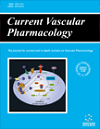- Home
- A-Z Publications
- Current Vascular Pharmacology
- Previous Issues
- Volume 5, Issue 3, 2007
Current Vascular Pharmacology - Volume 5, Issue 3, 2007
Volume 5, Issue 3, 2007
-
-
Cannabinoids and Cardiovascular Disease: The Outlook for Clinical Treatments
More LessAuthors: John C. Ashton and Paul F. SmithCannabinoid drugs exert their effects primarily through activation of cannabinoid CB1 and CB2 receptors. Both CB1 and CB2 receptors have been implicated in a number of cardiovascular processes, including vasodilation, cardiac protection, modulation of the baroreceptor reflex in the control of systolic blood pressure, and inhibition of endothelial inflammation and the progress of atherosclerosis in a murine model. These effect Read More
-
-
-
Novel Anti-Arrhythmic Drugs for Atrial Fibrillation Management
More LessAuthors: Joachim R. Ehrlich, Stanley Nattel and Stefan H. HohnloserAtrial fibrillation (AF) is a highly prevalent arrhythmia and responsible for significant morbidity, mortality and health care cost. Considerable work has been performed to improve medical options but treatment success still remains suboptimal. The use of conventional anti-arrhythmic agents has been limited by potentially fatal ventricular proarrhythmia. Thus, novel drug targets have been characterised and are currently bein Read More
-
-
-
Angiogenic Growth Factors in the Treatment of Peripheral Arterial Disease
More LessPeripheral arterial disease (PAD) remains a major cause of morbidity. Despite advances in revascularisation procedures and medical treatment, limb salvage and relief of pain are still not satisfactory in patients with severe disease. This has prompted the exploration of alternative modes of treatment including enhancement of new vessel formation (angiogenesis). Angiogenic Growth Factors (AGF), mainly Vascular Endothelial Read More
-
-
-
New Pharmacologic Approaches to Prevent Thromboembolism in Patients with Atrial Fibrillation
More LessAuthors: Matthias Hammwohner, Alessandra D'Alessandro, Oliver Wolfram and Andreas GoetteAtrial fibrillation (AF) is associated with a 6 fold increased risk for ischemic stroke. Observational studies suggest that one in four to five strokes is due to AF. Depending on the risk profile of an individual patient, the yearly risk for ischemic stroke is between 2% and 14%. AF is accompanied by an increased propensity for atrial clot formation due to a combination of decreased atrial blood flow, increased activity of the platelet/pl Read More
-
-
-
Is There a True Beneficial Effect of Statin Therapy in the Acute Phase of Unstable Angina or Myocardial Infarction?
More LessIt has been claimed that early use of statins in acute coronary syndromes (ACS) protects patients against recurrent ischemic events. This protective effect takes place as early as 4 months after treatment initiation in non-ST elevation ACS, as reported in the MIRACL trial. Mechanisms such as improvement in endothelial function and inflammation are possible explanations for this early effect. These findings have been used to p Read More
-
-
-
Beneficial Effects of Statins on Endothelial Dysfunction and Vascular Stiffness
More LessEndothelial dysfunction and increased arterial stiffness are considered independent predictors of cardiovascular risk. Endothelial dysfunction primarily reflects decreased availability of nitric oxide, a critical endothelium-derived vasoactive factor with vasodilatory and anti-atherosclerotic properties. Techniques for assessing endothelial dysfunction include ultrasonographic measurement of flow-mediated vasodilatation of t Read More
-
-
-
The Endothelin Axis: A Novel Target for Pharmacotherapy of Female Malignancies
More LessAuthors: Martin Smollich and Pia WulfingThe endothelin axis (ET axis), comprising the three peptides endothelin (ET)-1, -2, -3 and their receptors ETAR and ETBR, is expressed in various cells and tissues. The biologically active ET-1 is formed by endothelin-converting enzyme (ECE) from inactive big-ET-1. ET-1 has emerged as an important peptide in a host of biological functions, including development, cellular proliferation, apoptosis and angiogenesis, thereby pla Read More
-
Volumes & issues
-
Volume 23 (2025)
-
Volume 22 (2024)
-
Volume 21 (2023)
-
Volume 20 (2022)
-
Volume 19 (2021)
-
Volume 18 (2020)
-
Volume 17 (2019)
-
Volume 16 (2018)
-
Volume 15 (2017)
-
Volume 14 (2016)
-
Volume 13 (2015)
-
Volume 12 (2014)
-
Volume 11 (2013)
-
Volume 10 (2012)
-
Volume 9 (2011)
-
Volume 8 (2010)
-
Volume 7 (2009)
-
Volume 6 (2008)
-
Volume 5 (2007)
-
Volume 4 (2006)
-
Volume 3 (2005)
-
Volume 2 (2004)
-
Volume 1 (2003)
Most Read This Month
Article
content/journals/cvp
Journal
10
5
false
en


